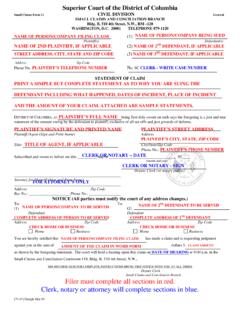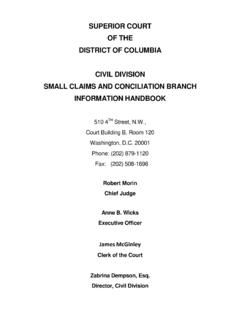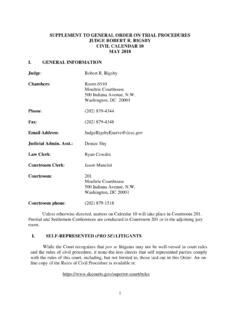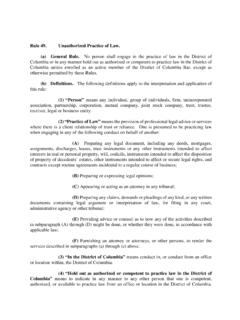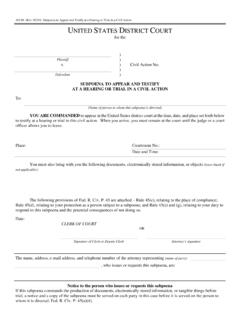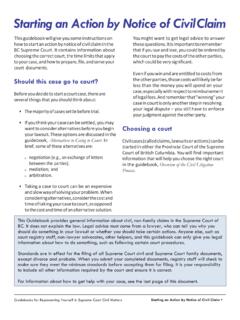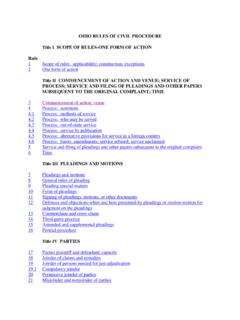Transcription of TITLE I. SCOPE OF RULES; FORM OF ACTION Rule 1. Scope …
1 TITLE I. SCOPE OF RULES; FORM OF ACTION . Rule 1. SCOPE and Purpose These rules govern the procedure in all civil actions and proceedings in the civil Division of the Superior Court of the District of Columbia, with the exception of cases in the Landlord and Tenant Branch and the Small Claims and Conciliation Branch of the court and other exceptions stated in Rule 81. They should be construed, administered, and employed by the court and the parties to secure the just, speedy, and inexpensive determination of every ACTION and proceeding. COMMENT TO 2017 AMENDMENTS. This rule was amended consistent with the 2007 and 2015 amendments to Federal Rule of civil Procedure 1. The addition of the phrase employed by the court and the parties is intended to emphasize that the court, parties, and attorneys are all responsible for using these rules to achieve the stated goals.
2 COMMENT. This Rule parallels Federal Rule of civil Procedure 1 but has been modified to reflect applicability to appropriate cases in the Superior Court. Note that these Rules do not, by their own terms, extend to cases in the Landlord and Tenant Branch or the Small Claims and Conciliation Branch; however, the separate Rules for those respective branches do designate certain of these Rules for incorporation by reference therein. Further, the SCOPE of these rules will necessarily be expanded in the future as new rules are promulgated to govern procedure in areas (such as probate) over which the court receives jurisdiction in subsequent increments. See Code (1967 Edition, Supplement IV) 11-921.
3 The phrase "these Rules" refers to the entire body of Superior Court Rules of civil Procedure, those derived from the Federal Rules of civil Procedure and those purely local Rules bearing numbers above 100. Any reference herein to a particular Rule, as, for example, "Rule 69" comprehends both the original Rule and any addenda thereto, , "69-I" and "69-II". Rule 2. One Form of ACTION There is one form of ACTION the civil ACTION . COMMENT TO 2017 AMENDMENTS. Stylistic changes were made to this rule to conform with the 2007 amendments to Federal Rule of civil Procedure 2. COMMENT. Identical to Federal Rule of civil Procedure 2. For ease of identification, the Clerk of the Court will place before the case number of every case filed in the civil Division appropriate prefixes as follows: "SC" for Small Claims and Conciliation Branch cases, "LT" for Landlord and Tenant Branch cases, "F" for Fiduciary cases, and "CA" for all other civil actions.
4 TITLE II. COMMENCING AN ACTION ; SERVICE OF PROCESS, PLEADINGS, MOTIONS, AND ORDERS. Rule 3. Commencing an ACTION A civil ACTION is commenced by filing a complaint with the court. COMMENT TO 2017 AMENDMENTS. Stylistic changes were made to this rule to conform with the 2007 amendments to Federal Rule of civil Procedure 3. COMMENT. Rule 3 identical to Federal Rule of civil Procedure 3. Rule 3-I. Actions Involving Real Property Any pleading the adjudication of which may affect TITLE to or interests in real property, including pleadings in change of name cases, must bear immediately below the TITLE of the pleading the inscription " ACTION INVOLVING REAL PROPERTY." On the filing of such a pleading, the clerk must place after the number assigned to the case the suffix "RP.
5 ". COMMENT TO 2017 AMENDMENTS. Under Rule 3-I, parties must identify pending actions that may impact the TITLE of real property in the District of Columbia. See First Md. Fin. Servs. Corp. v. District-Realty TITLE Ins. Corp., 548 787, 791 ( 1988) (citing Rule 3-I and quoting Anderson v. Reid, 14 App. 54, 68 (1899) for proposition that [t]he public records give constructive notice of their contents .. ). Rule 4. Summons (a) CONTENTS; AMENDMENTS. (1) Contents. A summons must: (A) name the court and the parties;. (B) be directed to the defendant;. (C) state the name and address of the plaintiff's attorney or if unrepresented of the plaintiff;. (D) state the time within which the defendant must appear and defend.
6 (E) notify the defendant that a failure to appear and defend will result in a default judgment against the defendant for the relief demanded in the complaint;. (F) be signed by the clerk; and (G) bear the court's seal. (2) Amendments. The court may permit a summons to be amended. (3) Service Outside the District of Columbia; Service in Suit Seeking Seizure of Property in the District of Columbia. A summons, or notice, or order in lieu of summons should correspond as nearly as possible to the requirements of a statute or rule whenever service is made pursuant to a statute or rule that provides for: (A) service of a summons, or notice, or order in lieu of summons on a party not an inhabitant of or found within the District of Columbia; or (B) service on or notice to a party to appear and respond or defend in an ACTION by reason of the attachment or garnishment or similar seizure of the party's property located within the District of Columbia.
7 (b) ISSUANCE. A prepared summons, with copies for each defendant named in the complaint, must be delivered to the clerk at the time the complaint is filed. If additional process is required, a prepared summons for the additional process must also be delivered to the clerk. On receipt and due notation, the clerk will return all but one copy of the summons to the plaintiff or the plaintiff's agent for service of process in accordance with Rule 4(c), recording on all copies the date of return to the plaintiff or the plaintiff's agent. (c) SERVICE. (1) In General. A summons must be served with a copy of the complaint, the Initial Order setting the case for an initial scheduling and settlement conference, any addendum to that order, and any other order directed by the court to the parties at the time of filing.
8 The plaintiff is responsible for having the summons, complaint, Initial Order, any addendum to that order, and any other order directed by the court to the parties at the time of filing served within the time allowed by Rule 4(m) and must furnish the necessary copies to the person who makes service. (2) By Whom. Any person who is at least 18 years of age and not a party may serve a summons and complaint. (3) By Marshal or Someone Specially Appointed. At the plaintiff's request, the court may direct that service be made by a United States marshal or deputy marshal or by a person specially appointed by the court. This request will only be granted when: (A) service is to be made on behalf of the United States or an officer or agency of the United States; or (B) the court issues an order stating that service by a United States marshal or deputy marshal or by a person specially appointed by the court is required for service to be properly made in that particular ACTION .
9 (4) By Registered or Certified Mail. Any defendant described in Rule 4(e), (f), (h), (i), (j)(1), or (j)(3) may be served by mailing a copy of the summons, complaint, Initial Order, any addendum to that order, and any other order directed by the court to the parties at the time of filing to the person to be served by registered or certified mail, return receipt requested, except as specified in Rule 4(i). (5) By First-Class Mail with Notice and Acknowledgment. (A) Requesting an Acknowledgment of Service. Any defendant described in Rule 4(e), (f), or (h) may be served by mailing by first-class mail, postage prepaid, to the person to be served: (i) a copy of the summons, complaint, Initial Order, any addendum to that order, and any other order directed by the court to the parties at the time of filing.
10 (ii) 2 copies of a Notice and Acknowledgment conforming substantially to civil ACTION Form 1-A; and (iii) a return envelope, postage prepaid, addressed to the sender. (B) Failure to Acknowledge Service. Unless good cause is shown for not doing so, the court must order the party served to pay: (i) the costs incurred in securing an alternative method of service authorized by this rule if the person served does not complete and return the Notice and Acknowledgment of receipt of the summons within 21 days after mailing; and (ii) the reasonable expenses, including attorney's fees, of any motion required to collect those service expenses. (6) Manner of Conducting Service. Service of process pursuant to Rule 4(c)(2) (4), or acknowledgment of service pursuant to Rule 4(c)(5), may, at the plaintiff's or the court's election, be attempted either concurrently or successively.
